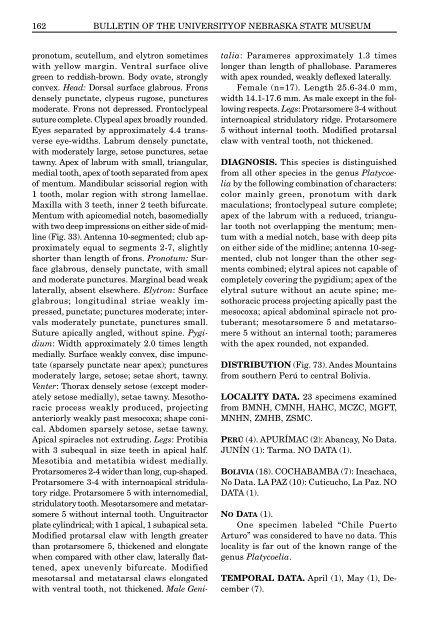Download full text (PDF 4.5 MB) - University of Nebraska State ...
Download full text (PDF 4.5 MB) - University of Nebraska State ...
Download full text (PDF 4.5 MB) - University of Nebraska State ...
You also want an ePaper? Increase the reach of your titles
YUMPU automatically turns print PDFs into web optimized ePapers that Google loves.
162 BULLETIN OF THE UNIVERSITYOF NEBRASKA STATE MUSEUM<br />
pronotum, scutellum, and elytron sometimes<br />
with yellow margin. Ventral surface olive<br />
green to reddish-brown. Body ovate, strongly<br />
convex. Head: Dorsal surface glabrous. Frons<br />
densely punctate, clypeus rugose, punctures<br />
moderate. Frons not depressed. Frontoclypeal<br />
suture complete. Clypeal apex broadly rounded.<br />
Eyes separated by approximately 4.4 transverse<br />
eye-widths. Labrum densely punctate,<br />
with moderately large, setose punctures, setae<br />
tawny. Apex <strong>of</strong> labrum with small, triangular,<br />
medial tooth, apex <strong>of</strong> tooth separated from apex<br />
<strong>of</strong> mentum. Mandibular scissorial region with<br />
1 tooth, molar region with strong lamellae.<br />
Maxilla with 3 teeth, inner 2 teeth bifurcate.<br />
Mentum with apicomedial notch, basomedially<br />
with two deep impressions on either side <strong>of</strong> midline<br />
(Fig. 33). Antenna 10-segmented; club approximately<br />
equal to segments 2-7, slightly<br />
shorter than length <strong>of</strong> frons. Pronotum: Surface<br />
glabrous, densely punctate, with small<br />
and moderate punctures. Marginal bead weak<br />
laterally, absent elsewhere. Elytron: Surface<br />
glabrous; longitudinal striae weakly impressed,<br />
punctate; punctures moderate; intervals<br />
moderately punctate, punctures small.<br />
Suture apically angled, without spine. Pygidium:<br />
Width approximately 2.0 times length<br />
medially. Surface weakly convex, disc impunctate<br />
(sparsely punctate near apex); punctures<br />
moderately large, setose; setae short, tawny.<br />
Venter: Thorax densely setose (except moderately<br />
setose medially), setae tawny. Mesothoracic<br />
process weakly produced, projecting<br />
anteriorly weakly past mesocoxa; shape conical.<br />
Abdomen sparsely setose, setae tawny.<br />
Apical spiracles not extruding. Legs: Protibia<br />
with 3 subequal in size teeth in apical half.<br />
Mesotibia and metatibia widest medially.<br />
Protarsomeres 2-4 wider than long, cup-shaped.<br />
Protarsomere 3-4 with internoapical stridulatory<br />
ridge. Protarsomere 5 with internomedial,<br />
stridulatory tooth. Mesotarsomere and metatarsomere<br />
5 without internal tooth. Unguitractor<br />
plate cylindrical; with 1 apical, 1 subapical seta.<br />
Modified protarsal claw with length greater<br />
than protarsomere 5, thickened and elongate<br />
when compared with other claw, laterally flattened,<br />
apex unevenly bifurcate. Modified<br />
mesotarsal and metatarsal claws elongated<br />
with ventral tooth, not thickened. Male Geni-<br />
talia: Parameres approximately 1.3 times<br />
longer than length <strong>of</strong> phallobase. Parameres<br />
with apex rounded, weakly deflexed laterally.<br />
Female (n=17). Length 25.6-34.0 mm,<br />
width 14.1-17.6 mm. As male except in the following<br />
respects. Legs: Protarsomere 3-4 without<br />
internoapical stridulatory ridge. Protarsomere<br />
5 without internal tooth. Modified protarsal<br />
claw with ventral tooth, not thickened.<br />
DIAGNOSIS. This species is distinguished<br />
from all other species in the genus Platycoelia<br />
by the following combination <strong>of</strong> characters:<br />
color mainly green, pronotum with dark<br />
maculations; frontoclypeal suture complete;<br />
apex <strong>of</strong> the labrum with a reduced, triangular<br />
tooth not overlapping the mentum; mentum<br />
with a medial notch, base with deep pits<br />
on either side <strong>of</strong> the midline; antenna 10-segmented,<br />
club not longer than the other segments<br />
combined; elytral apices not capable <strong>of</strong><br />
completely covering the pygidium; apex <strong>of</strong> the<br />
elytral suture without an acute spine; mesothoracic<br />
process projecting apically past the<br />
mesocoxa; apical abdominal spiracle not protuberant;<br />
mesotarsomere 5 and metatarsomere<br />
5 without an internal tooth; parameres<br />
with the apex rounded, not expanded.<br />
DISTRIBUTION (Fig. 73). Andes Mountains<br />
from southern Perú to central Bolivia.<br />
LOCALITY DATA. 23 specimens examined<br />
from BMNH, CMNH, HAHC, MCZC, MGFT,<br />
MNHN, ZMHB, ZSMC.<br />
PERÚ (4). APURÍMAC (2): Abancay, No Data.<br />
JUNÍN (1): Tarma. NO DATA (1).<br />
BOLIVIA (18). COCHABA<strong>MB</strong>A (7): Incachaca,<br />
No Data. LA PAZ (10): Cuticucho, La Paz. NO<br />
DATA (1).<br />
NO DATA (1).<br />
One specimen labeled “Chile Puerto<br />
Arturo” was considered to have no data. This<br />
locality is far out <strong>of</strong> the known range <strong>of</strong> the<br />
genus Platycoelia.<br />
TEMPORAL DATA. April (1), May (1), December<br />
(7).
















